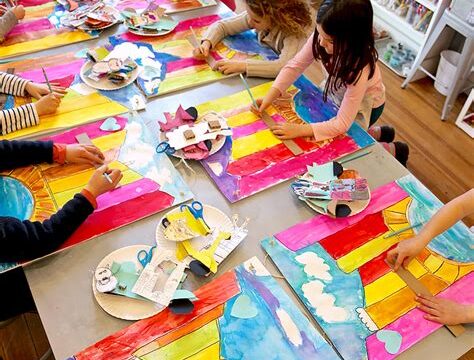Introduction to Creative Crafts for Kids
Engaging children in creative crafts is a wonderful way to nurture their imagination and creativity. Craft activities provide an outlet for children to express themselves, explore different materials and techniques, and develop important skills. Whether it’s painting, sculpting, or paper crafting, there are endless possibilities for kids to create something unique and special. In this blog post, we will delve into the reasons why creative crafts are beneficial for children and how they can ignite a lifelong passion for art and creativity.
Participating in craft workshops offers numerous benefits for children’s overall development. First and foremost, it allows them to unleash their creativity and think outside the box. By giving kids the freedom to experiment and make choices, they learn to trust their instincts and develop their unique artistic style. Craft workshops also promote problem-solving and critical thinking skills. When faced with challenges or design dilemmas, children must come up with creative solutions, honing their problem-solving abilities.
Exploring different craft techniques and materials is an essential aspect of a child’s creative journey. From painting and drawing to sculpting and collage-making, kids can discover a wide range of art forms. By exposing them to various techniques, children can find what resonates with them and expand their artistic horizons. Moreover, using different materials helps enhance their sensory perception and fine motor skills. As children manipulate various textures and shapes, they strengthen their hand-eye coordination and develop dexterity.
- Benefits of participating in craft workshops:
- Ignites imagination and creativity
- Promotes problem-solving and critical thinking
- Develops fine motor skills
- Enhances sensory perception
- Expands artistic horizons
Engaging kids in creative crafts also fosters their imagination. Through art, children can turn simple materials into something extraordinary, allowing their ideas to come to life. Craft activities provide a platform for self-expression, where kids can communicate their thoughts, emotions, and imaginations. This freedom of expression nurtures their self-confidence and self-esteem, as they realize the power of their own creativity.
A final showcase and celebration of kids’ creations is a pivotal aspect of artistic endeavors. It provides a sense of accomplishment and pride for children, as their hard work is recognized and appreciated by others. When kids see their finished crafts displayed or receive positive feedback, it reinforces their belief in their abilities and encourages them to pursue further artistic ventures. This celebration also helps build a sense of community and camaraderie among young artists, fostering a supportive and encouraging environment.
| Benefits of Creative Crafts for Kids | Key Points |
|---|---|
| Unleashing imagination and creativity | Nurturing self-expression and communication |
| Promoting problem-solving and critical thinking | Developing fine motor skills and sensory perception |
| Expanding artistic horizons | Fostering self-confidence and self-esteem |
| Celebrating kids’ creations | Fostering a supportive artistic community |
Benefits of Participating in Craft Workshops
Participating in craft workshops can have numerous benefits for both children and adults alike. These workshops provide a unique opportunity to explore and express one’s creativity through various craft techniques and materials. Not only do they provide a platform for individuals to engage in a hands-on learning experience, but they also offer a multitude of advantages that can positively impact personal growth and development.
One of the key benefits of participating in craft workshops is the opportunity to learn and develop new skills. These workshops often focus on teaching specific craft techniques, such as painting, pottery, paper crafts, or jewelry making. By actively participating in these workshops, individuals can acquire practical skills and knowledge that can be further honed and utilized in their personal and professional lives.
Moreover, craft workshops provide a platform for individuals to connect and engage with like-minded individuals. Whether it’s a children’s craft workshop or an adult-focused session, these workshops create a sense of community and foster social interaction. Participants can share ideas, learn from each other’s experiences, and even collaborate on creative projects. This not only enhances the overall learning experience but also promotes teamwork and cooperation.
In addition to skill-building and social interaction, participating in craft workshops can also have positive effects on one’s mental well-being. Engaging in creative activities has been proven to reduce stress levels and improve overall mood. The process of creating and completing a craft project provides a sense of accomplishment and fulfillment, boosting self-esteem and confidence. Furthermore, crafts serve as a form of self-expression, allowing individuals to tap into their imagination and unleash their creativity.
In conclusion, participating in craft workshops offers a plethora of benefits for individuals of all ages. Whether it’s learning new skills, forming social connections, or improving mental well-being, these workshops provide a unique and enriching experience. So, if you’re looking to explore your creative side or simply want to engage in a fun and rewarding activity, consider participating in a craft workshop and unlock the numerous benefits it has to offer.
Exploring Different Craft Techniques and Materials
When it comes to engaging in creative crafts for kids, one of the most exciting aspects is exploring different craft techniques and materials. This not only sparks curiosity and imagination but also helps children develop a wide range of skills and abilities. By introducing them to various techniques and materials, we can provide them with opportunities to experiment, learn, and grow.
One of the benefits of exploring different craft techniques is that it allows children to discover their own unique style and preferences. Whether it’s painting, drawing, sculpting, or collage-making, exposing kids to various techniques enables them to express their creativity in different ways. They can experiment with different brush strokes, shading techniques, or texture applications, allowing their imagination to run wild and their artwork to flourish.
Furthermore, using a wide range of materials in crafts helps children develop their sensory skills. From soft and smooth fabrics to rough and textured ones, from colorful and vibrant papers to shiny and reflective surfaces, kids get to feel and explore different sensations. This sensory exploration not only enhances their awareness of the world around them but also strengthens their fine motor skills as they manipulate and play with different materials.
- Painting
- Drawing
- Sculpting
- Collage-making
Additionally, engaging in diverse craft techniques and materials promotes problem-solving and critical thinking skills. Children are encouraged to think creatively, find solutions to challenges, and make decisions about color combinations, design arrangements, and material usage. This helps them develop their cognitive abilities and nurtures their problem-solving skills, which are essential for their overall development.
| Advantages of Exploring Different Craft Techniques and Materials: |
|---|
| 1. Encourages creativity and self-expression |
| 2. Enhances sensory skills and fine motor skills |
| 3. Promotes problem-solving and critical thinking |
| 4. Allows discovery of unique style and preferences |
In conclusion, exploring different craft techniques and materials opens up a world of possibilities for kids to express themselves, learn new skills, and develop their cognitive abilities. By providing them with a variety of techniques and materials, we empower them to think creatively, problem-solve, and unleash their imagination. So, let’s encourage our little ones to explore the endless possibilities of creative craft making!
Engaging Kids’ Imagination and Creativity
The key to engaging kids’ imagination and creativity is to provide them with opportunities to explore and express themselves through various creative activities. Whether it’s drawing, painting, crafts, or even storytelling, engaging in these activities allows children to tap into their imagination and unleash their creativity.
One of the benefits of engaging kids’ imagination and creativity is that it helps them develop their own unique ideas and perspectives. When children are encouraged to think creatively, they learn to think outside the box and come up with innovative solutions to problems. This kind of thinking is not only valuable in creative pursuits but also in everyday life.
Another benefit of engaging kids’ imagination and creativity is that it helps foster a sense of self-expression and individuality. By encouraging children to express themselves creatively, whether it’s through art, music, or writing, they develop a sense of identity and confidence in their own abilities. This self-expression is crucial for their overall development and well-being.
- Boosts problem-solving skills
- Enhances communication skills
- Improves concentration and focus
- Develops resilience and perseverance
| Creative Activities | Benefits |
|---|---|
| Drawing and Painting | Enhances fine motor skills |
| Writing and Storytelling | Improves language and communication skills |
| Crafts and DIY projects | Promotes critical thinking and problem-solving |
In conclusion, engaging kids’ imagination and creativity through various creative activities has numerous benefits. It not only helps them develop their own unique ideas and perspectives but also fosters self-expression and individuality. Additionally, it boosts problem-solving skills, enhances communication skills, improves concentration and focus, and develops resilience and perseverance. So, let’s encourage children to explore their imagination and unleash their creativity!
Developing Fine Motor Skills through Crafts
Engaging children in craft activities is not only a fun way to spend time, but it also has numerous developmental benefits. One of the key areas of development that crafting can help with is fine motor skills. Fine motor skills involve the coordination of small muscles in the hands and fingers, and they are essential for tasks such as buttoning clothes, tying shoelaces, and writing. By engaging in various craft projects, children can enhance their fine motor skills in a creative and enjoyable way.
There are several ways in which crafts can contribute to the development of fine motor skills. Firstly, activities that involve cutting, such as paper crafts or using child-safe scissors, require children to practice their hand-eye coordination and control. They have to hold the paper or materials steady with one hand while using the other hand to accurately cut along the lines. This helps improve their precision and stability in using small tools.
In addition to cutting, crafts also involve other actions that require dexterity and control, such as painting, drawing, and gluing. These activities encourage children to hold paintbrushes or glue sticks, grip pencils or markers, and manipulate various materials with their fingers. By repeatedly practicing these movements, children enhance their hand strength, finger control, and overall fine motor skills. As they develop their abilities in crafting, they become more confident in handling smaller and more intricate tasks.
Aside from the physical benefits, engaging in crafts can also have a positive impact on children’s cognitive development. Crafts often require problem-solving and critical thinking skills, as children have to figure out how to assemble different pieces, follow instructions, and make creative decisions. These mental processes further stimulate their brain development and contribute to their overall cognitive growth.
- Improved hand-eye coordination: Engaging in crafts helps children develop better coordination between their hands and eyes, as they have to guide their movements while looking at what they are doing.
- Enhanced finger control: Crafts that involve manipulating small objects or tools, such as beads or clay, help children improve their finger control and dexterity.
- Increased hand strength: Repeatedly engaging in crafts that require gripping, such as using paintbrushes or kneading dough, can strengthen children’s hand muscles.
| Skills Developed: | Benefits: |
|---|---|
| Hand-eye coordination | Improved ability to control hand movements and visual focus |
| Fine motor skills | Enhanced ability to use small muscles for precise movements |
| Problem-solving | Development of logical thinking and creative decision-making |
Promoting Problem-solving and Critical Thinking
Craft activities are an excellent way to promote problem-solving and critical thinking skills in children. When engaged in crafting, children are constantly faced with challenges and obstacles that require them to think creatively and find solutions. For example, when creating a sculpture using clay, a child may encounter difficulties in shaping the clay or achieving the desired form. In order to overcome these challenges, they need to think critically and problem-solve by experimenting with different techniques and materials. This process encourages them to think outside the box and come up with innovative solutions.
Furthermore, craft activities often involve following instructions and completing specific tasks. Children have to carefully read or listen to the instructions, interpret them, and then implement them accordingly. This not only enhances their reading and listening skills but also develops their ability to analyze information and follow directions accurately. Craft projects that require step-by-step instructions, such as assembling a model or constructing a diorama, can be particularly effective in fostering problem-solving and critical thinking skills.
In addition to problem-solving, crafting also encourages children to think critically. They are encouraged to evaluate their work and make decisions throughout the creative process. For instance, a child may need to assess the color combinations in a painting or determine the best way to arrange pieces of a mosaic. These decisions require them to think critically, analyze different options, and make choices based on their own judgment. Such exercises allow children to develop their decision-making abilities and develop a sense of autonomy.
Benefits of Promoting Problem-solving and Critical Thinking in Children
- Enhances problem-solving skills
- Encourages creative thinking
- Develops analytical abilities
- Improves decision-making skills
- Boosts confidence and self-esteem
- Fosters a sense of independence
- Prepares children for future challenges
Table: Examples of Craft Activities that Promote Problem-solving and Critical Thinking
| Craft Activity | Skills Developed |
|---|---|
| Building a model car or airplane | Problem-solving, following instructions, attention to detail |
| Designing and constructing a puzzle | Critical thinking, spatial reasoning, design skills |
| Creating a robot from recycled materials | Problem-solving, creativity, engineering skills |
| Making a collage using various materials | Critical thinking, decision-making, visual aesthetics |
In conclusion, involving children in craft activities helps promote problem-solving and critical thinking skills. These activities provide opportunities for children to face challenges, think creatively, and find solutions. Craft projects that require following instructions and making decisions further enhance these skills. By encouraging problem-solving and critical thinking, crafts empower children with important life skills that will benefit them in various aspects of their lives.
Final Showcase and Celebration of Kids’ Creations
Once the creative crafts for kids workshops have come to an end, it is time to showcase and celebrate the amazing creations that the children have made throughout the program. This final showcase is not only a way for the participants to display their artwork, but also a way to recognize and appreciate their hard work and dedication. The celebration is a special event where family and friends are invited to come and see the masterpieces the children have created.
During the final showcase, each child’s artwork is displayed in a designated area. The display can be organized in various ways, such as by theme, technique, or materials used. This allows everyone to appreciate the variety and uniqueness of each child’s creations. The use of list tags can help in categorizing the artwork or describing the different techniques used. For example:
- Paintings: A collection of colorful and vibrant acrylic paintings.
- Sculptures: Three-dimensional creations made from clay and recycled materials.
- Collages: Artworks composed by combining various materials such as paper, fabric, and buttons.
The final showcase not only provides a platform for the children to exhibit their artwork but also encourages them to speak about their creative process. Each child can take turns explaining their inspiration, techniques used, and the story behind their masterpiece. This helps boost their confidence and public speaking skills, as well as allowing others to gain a deeper appreciation for their creations. Additionally, using table tags can create organized spaces for the children to display their artwork and interact with the audience.
Frequently Asked Questions
Q: What are the benefits of participating in craft workshops for kids?
A: Participating in craft workshops can help develop kids’ creativity, improve their problem-solving and critical thinking skills, and enhance their fine motor skills.
Q: What craft techniques and materials can kids explore in these workshops?
A: Kids can explore a wide range of craft techniques such as painting, drawing, paper crafts, clay modeling, and more. They can also work with various materials like paint, paper, beads, feathers, and fabric.
Q: How do creative crafts engage kids’ imagination?
A: Creative crafts allow kids to express their unique ideas, concepts, and stories through art. By engaging in crafts, kids can use their imagination to create and design different objects and artworks.
Q: How does participating in craft workshops help develop kids’ fine motor skills?
A: Crafting activities like cutting, coloring, and assembling require kids to use their hands and fingers, improving their dexterity and coordination. This helps in developing their fine motor skills, which are essential for tasks like writing and buttoning clothes.
Q: How do craft workshops promote problem-solving and critical thinking in kids?
A: Craft workshops often involve following instructions, making decisions, and finding creative solutions to challenges or design problems. This encourages kids to think critically, make choices, and solve problems, enhancing their problem-solving and critical thinking abilities.
Q: How can kids showcase and celebrate their creations from craft workshops?
A: Craft workshops usually end with a final showcase or exhibition where kids can display their artworks or crafts. This allows them to feel proud of their creations, share them with others, and receive positive feedback and recognition for their efforts.
Q: How can parents or guardians find craft workshops for their kids?
A: Parents or guardians can find craft workshops for kids by searching online, checking local community centers, art studios, or libraries, or by contacting schools or educational institutions. They can also seek recommendations from other parents or join social media groups related to kids’ crafts.





